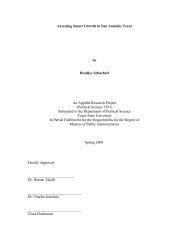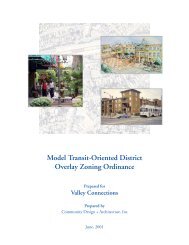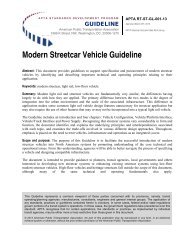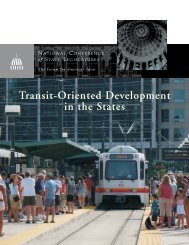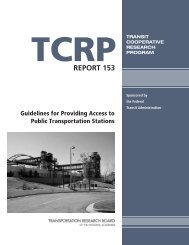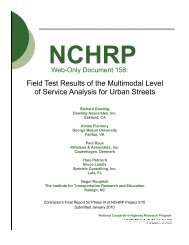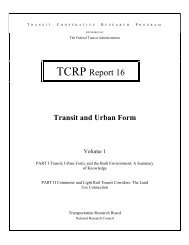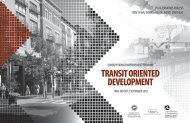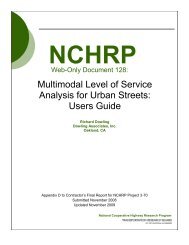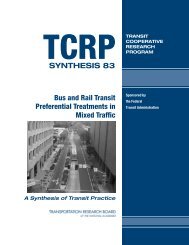the colorado mile markers: recommendations for measuring ...
the colorado mile markers: recommendations for measuring ...
the colorado mile markers: recommendations for measuring ...
Create successful ePaper yourself
Turn your PDF publications into a flip-book with our unique Google optimized e-Paper software.
AT Mile Markers<br />
The prioritized indicators—<strong>the</strong> AT Mile Markers—correspond<br />
with key sections in <strong>the</strong> report and are presented below.<br />
1. Demand <strong>for</strong> AT at <strong>the</strong> Population Level:<br />
• WT: Number of walk trips per capita<br />
• BT: Number of bicycle trips per capita<br />
2. Demand <strong>for</strong> AT at <strong>the</strong> Facility Level:<br />
• AT-W: Average traffic-walking<br />
• AT-B: Average traffic-bicycling<br />
3. Facility Supply <strong>for</strong> AT:<br />
• fm-W: Facility <strong>mile</strong>s <strong>for</strong> walking by class of facility<br />
• fm-B: Facility <strong>mile</strong>s <strong>for</strong> bicycling by class of facility<br />
4. Community Environment Supports <strong>for</strong> AT (including<br />
a safety component):<br />
• Colorado Ped Score<br />
• Colorado Bike Score<br />
Monitoring <strong>the</strong> AT Mile Markers<br />
There are a variety of potential data sources to consider when<br />
implementing <strong>the</strong> AT Mile Markers.<br />
1. State-level population: For ongoing monitoring, add<br />
questions to an existing national population-based<br />
survey such as <strong>the</strong> Behavioral Risk Factor Surveillance<br />
System coordinated by <strong>the</strong> CDC. This would use what<br />
are considered to be “best practice,” “reliable,” and easily<br />
comparable questions akin to those in <strong>the</strong> survey <strong>for</strong><br />
<strong>the</strong> Front Range Travel Counts or National Household<br />
Travel Survey.<br />
2. Local-level population: To obtain better data about<br />
local changes conduct a rolling and/or competitively<br />
awarded set of local-level randomly sampled surveys<br />
(likely using mail-out/mail-back and internet options).<br />
This is inexpensive, can reach a wide population, and<br />
can be conducted as a one-off or as ongoing surveillance.<br />
3. Local-level population: Leverage new technologies<br />
(such as applications and GPS on smart phones or bikes)<br />
by developing an experimental program. This could<br />
also involve GPS-assisted travel surveys.<br />
4. Facility use: Enhance and standardize automated<br />
monitoring of facilities such as paths and sidewalks.<br />
Examples include in-ground and infrared sensors, and<br />
traffic cameras.<br />
5. Facility provision: Create and update a state-level<br />
database of off-road facilities <strong>for</strong> walking and cycling<br />
and facilities on principal roadways. A consistent, statewide<br />
classification of such facilities will aid in this activity.<br />
6. Safety: Centralize collection of data on bicycle and<br />
pedestrian accidents and injuries.<br />
7. Supports: An experimental program of rating <strong>for</strong><br />
pedestrian and cycling friendliness using widely available<br />
data (census, roads, facilities) akin to Walkscore.<br />
com. These indicators, <strong>the</strong> Colorado Walk Score and <strong>the</strong><br />
Colorado Bike Score, would help communities understand<br />
<strong>the</strong> degree to which AT is supported.<br />
The full report details <strong>the</strong> measurement approaches and instruments,<br />
and <strong>the</strong>ir alternatives. It also outlines specific indicators<br />
that can be derived from <strong>the</strong>se instruments.<br />
The Colorado Mile Markers • Recommendations <strong>for</strong> Measuring Active Transportation • May 2012 • Page 6



